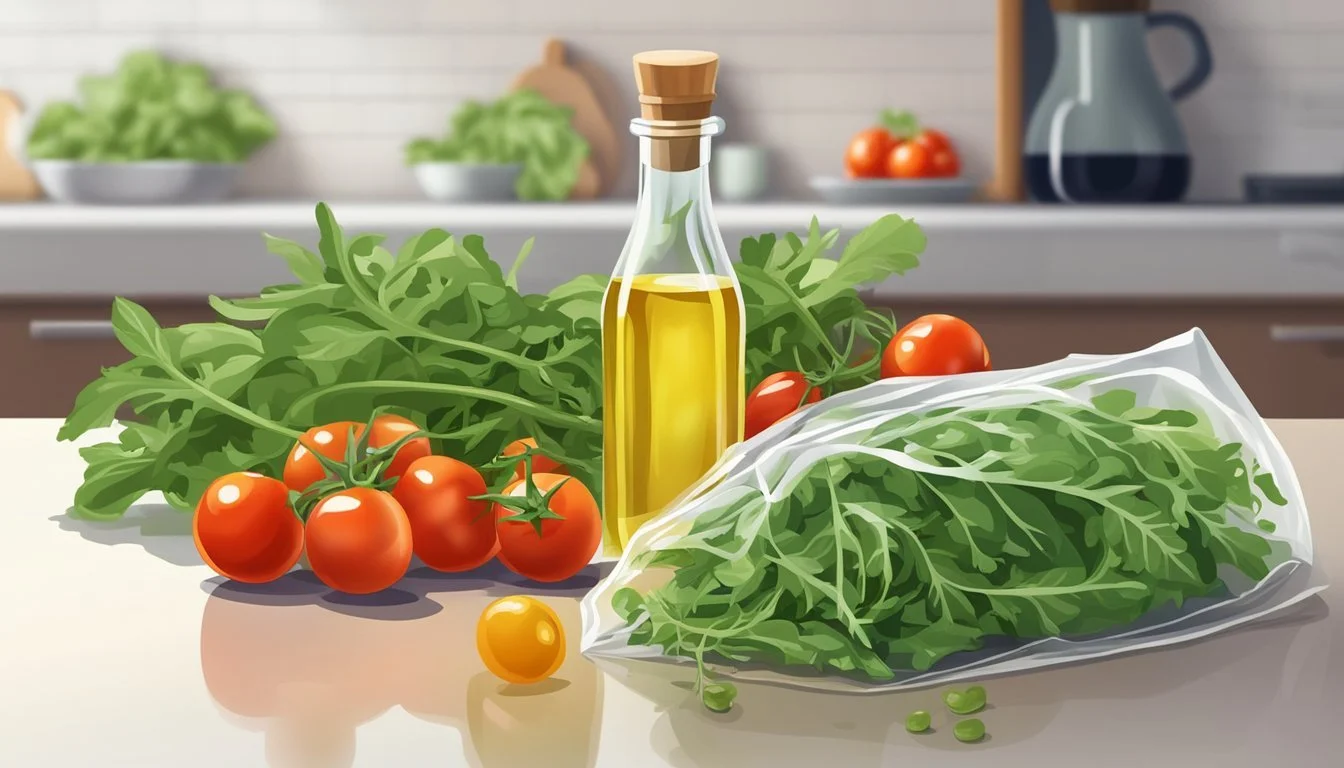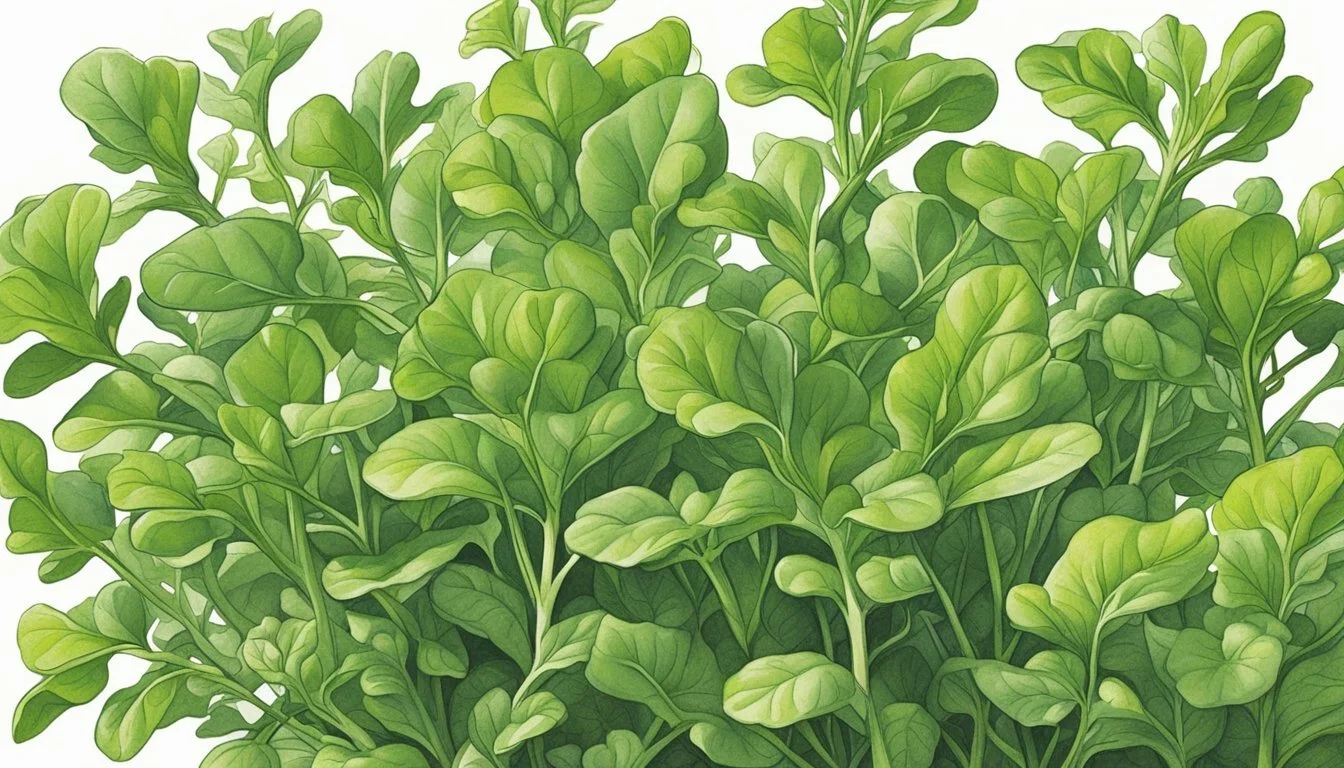How Long Does Arugula Last?
Understanding Shelf Life and Storage Tips
Arugula, a peppery and nutritious green also known as rocket, has become a staple in salads and a garnish atop a variety of dishes. Its shelf life, like many leafy greens, is influenced by factors ranging from the time of harvest to the method of storage. Typically, when stored properly in the refrigerator, arugula can last from three to seven days. The key to prolonging its freshness lies in maintaining the right environment—cool and dry—once it makes its way from the grocery store to the home kitchen.
To ensure the longevity of arugula, it should be stored in an airtight container or plastic bag to shield it from moisture, which accelerates decay. Unwashed leaves fend off spoilage better than their washed counterparts due to the absence of additional moisture. For those looking to extend the life of their arugula even further, freezing is an option, though it may alter the texture, making it more suitable for cooked dishes rather than fresh salads. Blanching the leaves before freezing can help preserve the flavor and nutrients for up to six months.
Mindful handling is equally important; arugula's delicate leaves are prone to bruising which can advance spoilage. It is recommended to handle the greens gently and trim any thick stalks that aren't needed. These careful steps ensure that arugula offers its bold flavor to meals for as long as possible, minimizing food waste and retaining its nutritional benefits.
Arugula Overview
Arugula, a popular leafy green vegetable with a distinct peppery flavor, is considered a powerhouse of nutrition and versatility in culinary applications.
Nutritional Profile
Arugula is a nutrient-rich leafy green, providing a variety of vitamins and minerals essential to maintaining good health. It is an excellent source of Vitamin A and Vitamin K, and also contains calcium, potassium, folate, and iron. In terms of antioxidants, arugula houses compounds that contribute to its health benefits, including combating oxidative stress.
Key Nutrients in Arugula:
Vitamin A: Essential for eye health and immune function.
Vitamin K: Crucial for blood clotting and bone health.
Calcium: Important for bone health and muscular function.
Iron: Necessary for blood cell production and oxygen transport.
Potassium: Helps regulate fluid balance and nerve signals.
Folate: Supports DNA synthesis and cell division.
Culinary Uses
In the culinary world, arugula is appreciated for its peppery flavor that adds a spicy kick to a variety of dishes. It is often used fresh in salads and as a garnish, but can also be incorporated into sandwiches, pizzas, pasta dishes, and more. Its flavor profile and nutritional value make it a sought-after green for both home cooks and professional chefs.
Common Culinary Applications of Arugula:
Fresh salads
Topping for pizzas and sandwiches
Ingredient in pasta and grain bowls
Base for pesto and sauces
Proper Storage Techniques
Effective storage of arugula is crucial to maintain its freshness and maximize its shelf life. Careful attention to moisture control, temperature settings, and the use of appropriate containers can significantly extend the longevity of this leafy green.
Refrigeration
To store arugula in the refrigerator, it is essential to keep it at a consistent, cool temperature. Ideally, placing arugula in the vegetable crisper drawer helps regulate humidity and temperature. One should ensure that the arugula is dry before storage to prevent excess moisture, which can lead to decay. Lining a storage container with paper towels can assist in absorbing any residual moisture.
Typical Refrigerator Storage Steps:
Dry the arugula thoroughly with a paper towel.
Line a container with a dry paper towel.
Place arugula on top and cover with another paper towel.
Store in the refrigerator's crisper drawer for three to seven days.
Freezing Arugula
Although not commonly recommended due to texture changes, freezing arugula is a viable option for long-term storage. Prior to freezing, one should blanch the leaves to preserve color and nutrients. After cooling and drying, arugula can be stored in an airtight container or freezer-safe bags. To minimize excess air, squeeze out as much air as possible.
Freezing Process:
Blanch arugula leaves and cool rapidly.
Dry leaves completely.
Place in airtight containers or freezer bags.
Label with date and store in the freezer.
Airtight Containers
For both refrigeration and freezing, using airtight containers is critical to protect arugula from ethylene gas, which is produced by some fruits and vegetables and can accelerate spoilage. The container should be large enough to not overcrowd the leaves but small enough to prevent excess air. If a specialized airtight container is not available, a regular container can be made more suitable with a few adjustments.
Airtight Storage Recommendations:
In the fridge: Use an airtight container lined with paper towels or store in the original packaging if it is resealable and undamaged.
For freezing: Use sealed bags, ensuring as little air as possible remains inside.
Preserving Freshness and Quality
When storing arugula, one's primary goals are to maintain its vibrant color, crisp texture, and overall freshness. Proper storage methods can prevent spoilage and extend the vegetable's shelf life.
Preventing Wilt and Discoloration
To prevent arugula from becoming wilted or discolored, store it in a plastic bag or container after rinsing and thoroughly drying the leaves. Excess moisture can lead to slimy or mushy leaves. Including a dry paper towel inside the bag or container can absorb residual moisture, thus reducing the risk of spoilage.
Rinse: Carefully under cold water to remove dirt and debris.
Dry: Gently with a towel to remove excess water.
Extending Shelf Life
Arugula's shelf life can be maximized by refrigerating it promptly. The ideal storage is in an airtight container with minimal air exposure to avoid deterioration. If stored properly, arugula can remain fresh for approximately 3 to 7 days.
Container: Airtight to reduce exposure to air.
Refrigeration: Necessary to slow down spoilage.
Handling and Preparation
Before storing, arugula should be prepped correctly. It should be rinsed thoroughly but gently to maintain its quality, then carefully patted dry. Avoid any rough handling that could bruise the leaves. Clipping any large stems can also help preserve the quality and texture of arugula leaves during storage.
Handling: Gently to prevent damage.
Preparation: Stems clipped and leaves dried.
Signs of Spoilage
Recognizing the signs of spoilage in arugula is crucial for ensuring food safety and quality. Distinct changes in appearance and smell are the primary indicators that the leafy green is no longer fit for consumption.
Visual Indicators
Arugula that has gone bad typically exhibits several visual cues. One should look for:
Color: Healthy arugula leaves should have a vibrant green hue. Leaves that appear yellow or have developed brown spots indicate spoilage.
Mold: The presence of mold, which may appear as fuzzy or slimy spots, is a clear sign the arugula should be discarded.
Texture and Aroma
Apart from visual changes, the texture and aroma of arugula are also telling:
Texture: Fresh arugula leaves are crisp. If the leaves are wilted or slimy, this suggests they have spoiled.
Aroma: Arugula typically has a slightly peppery, yet mildly earthy scent. A sour or musty smell is a strong indication the arugula is rotten and should not be used.
Utilizing Arugula in Cooking
Arugula, with its peppery and pungent flavor profile, enhances a variety of dishes, from fresh salads to complex cooked meals (how long do cooked meals last?). Its versatility in the kitchen makes it a popular spicy herb for culinary experimentation.
Fresh Applications
Arugula is commonly enjoyed raw and brings a spicy kick to salads. Its robust flavor complements milder greens and can balance the sweetness of fruits such as pears or apples. When using arugula, they may incorporate it into:
Salads: A simple arugula salad with a vinaigrette dressing.
Sandwiches: Layered with meats or cheeses for an added spicy flavor.
Cooking Techniques
While arugula is often consumed fresh, it can also be a flavorful addition to cooked dishes. To maintain its flavor, chefs recommend adding arugula at the very end of the cooking process. Applications include:
Sautéing: Briefly cooking arugula to wilt it, often as a pizza topping or stirred into pasta.
Blending: Making arugula pesto for a spicier variation of the classic basil pesto.
Arugula-Based Dishes
Thanks to its distinct peppery taste, arugula can be the star in specific dishes. Chefs might create:
Pesto: Utilizing arugula instead of basil for a spicy kick in pesto sauce.
Pizza: Topped with fresh arugula after baking for a peppery contrast to the rich cheese.
Freezing and Thawing Procedures
When preserving arugula for long periods, freezing is an effective method, and thawing it correctly is crucial for maintaining quality. These steps should ensure arugula retains its texture and flavor as much as possible through the freezing and thawing processes.
How to Freeze Arugula
Blanching: Blanching arugula is a necessary step before freezing. This involves submerging the arugula leaves in boiling water for 30-60 seconds and then promptly transferring them to ice water to halt the cooking process.
Drying: After blanching, the leaves should be thoroughly dried with a clean towel. This step is crucial to prevent the formation of ice crystals that can degrade the leaves' texture.
Pre-Freezing: Arrange the arugula in a single layer on a baking sheet lined with parchment paper, avoiding overcrowding. This step is called flash freezing and is done before transferring the leaves to an airtight container or freezer bag.
Storing: Once frozen solid, the arugula should be transferred to airtight containers or freezer bags. Removing as much air as possible from the bag helps prevent freezer burn and extends the shelf life of the arugula.
Thawing for Use
Refrigerator Method: The recommended method to thaw frozen arugula is in the refrigerator. It is a slow process but helps maintain the leaf's integrity.
Direct Use: In some cases, arugula can be used directly from the freezer, especially when it will be cooked, such as in soups or stews. This method negates the need for the thawing process entirely.
Growing and Harvesting Your Own Arugula
Growing arugula in one's garden provides a fresh produce option that's not only tasty but also a superb addition to a variety of dishes. Harvesting it correctly ensures a continuous supply of tender leaves.
Cultivation Tips
When embarking on the journey to grow arugula, gardeners should note that it belongs to the Brassicaceae family, making it a relative to broccoli and kale. It prefers cooler weather, making it an excellent spring or fall crop. Sowing seeds should be done:
Depth: ¼-inch deep
Spacing: 1 inch apart in rows or broadcast amidst other salad greens
Row Spacing: 10 inches apart
Germination takes approximately one week, which may extend slightly in cold soil. To speed up germination, soaking the seeds in water for a few hours before planting is advisable.
Harvesting and Post-Harvest
Arugula grows quickly and can be harvested when the leaves reach 2 to 3 inches long. Harvesting should be done:
First harvest: When three rows of leaves exist and outer leaves are about 2 inches
Method: Cut the outer leaves at the base or pinch with fingernails
Frequency: As new leaves emerge, continue to harvest outer leaves
It's crucial to harvest regularly to encourage new growth and prevent the plant from bolting, which can cause the leaves to become tough and bitter. After cutting, arugula should be washed and stored in the refrigerator to maintain freshness.
Arugula's Role in a Healthy Diet
Arugula, often considered a staple in healthy eating regimes, packs a potent punch of nutrients in a low-calorie profile. Its role in a balanced diet is notable due to its rich variety of vitamins and minerals that support overall health.
Health Benefits
Nutritious Profile: Arugula is a leafy green known for its high nutritional value. In just one cup of arugula, consumers benefit from a mere 5 calories while gaining access to a wealth of vitamins and minerals.
Vitamins and Minerals: Rich in vitamin K for healthy bones and blood clotting, arugula also provides a good source of folate, essential for DNA and RNA production. It contains iron, which is vital for oxygen transport, and calcium, necessary for bone health.
Antioxidant Properties: This vegetable is packed with antioxidants which help protect the body from harmful free radicals and may reduce the risk of chronic diseases.
Incorporating Arugula into Meals
Arugula's versatility makes it easy to incorporate into meals:
Salads: Start with a base of fresh arugula to create a nutrient-dense salad. Pair it with tomatoes, cucumbers, and a vinaigrette for a classic combination.
Pesto: Blend arugula with garlic, nuts, Parmesan, olive oil, and lemon juice for a nutty-flavored pesto.
Pizza and Sandwiches: Add raw arugula on top of a pizza or into sandwiches and wraps to inject a peppery, mustard green-like kick.
Cooked Greens: Sauté arugula like other cooking greens to accompany proteins or fold into pastas and grains.
Arugula's nutty flavor complements a wide range of dishes, from the simplicity of a raw salad to the heartiness of a cooked meal, while contributing significantly to the nutritional content of these foods.
Understanding Arugula's Shelf Life
Arugula, a leafy green known for its peppery flavor, has a variable shelf life that largely depends on storage conditions and handling. This section examines the typical duration for which arugula remains fresh and the factors influencing this timeframe.
Average Lifespan
Typically, arugula can last in the refrigerator for up to five days when stored correctly. Proper storage involves placing the arugula in an airtight container or plastic bag to minimize exposure to air. If freezing, arugula may retain quality for six to eight months, although it's best used in cooked dishes after thawing, as the texture may become limp.
Factors Affecting Longevity
Two key factors influence arugula's shelf life:
Temperature: Arugula should always be kept refrigerated. At room temperature, its shelf life diminishes rapidly due to faster bacterial growth and loss of moisture, leading to wilting.
Moisture: After washing arugula, it should be thoroughly dried before storage to avoid creating an environment conducive to bacteria. Excess moisture can accelerate spoilage and reduce shelf life.
By understanding these aspects, one can prolong the freshness and edibility of arugula.









